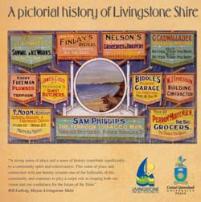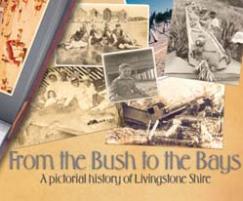Pictorial history of Livingstone Shire latest from Press
Published on 21 November, 2005
A pictorial history of Livingstone Shire entitled 'From The Bush to the Bays' is the latest publication from CQU Press.
The joint venture between the Press and Livingstone Shire Council will be launched in a garden party atmosphere from 2pm on Saturday, December 17 at the LSC Library in Yeppoon.
According to CQU Press Publisher Professor David Myers "ladies will be invited to wear period costume and carry parasols ... gentlemen may fish out their Edwardian best with spats and bowler hats".
Mayor Bill Ludwig will deliver a speech to mark the occasion.
The book will sell to all participants for only $25 (the recommended retail price in shops is $29.95).
 The following is a review of the book by Kristin Hannaford.
The following is a review of the book by Kristin Hannaford.
Can you imagine what it must have been like living in Central Queensland during the early pioneering days? Well you can see for yourself in 'From the Bush to the Bays: A Pictorial History of Livingstone Shire', a book which celebrates unique and universal aspects of Australian life throughout more than a century of change.
Chapters quaintly titled ‘Fun in the Sun’, ‘Harvesting the Land’ and ‘Goin to Town’ pay homage to the life and times of a diverse shire which encompasses both rural and seaside communities.
This book is the first comprehensive photographic history of the region and is completely unique in its approach. Photographs and images were garnered from family holiday snaps, social club folders, personal nostalgia and memorabilia – the book is a delight to explore with over 400 images from private and public collections. With so many previously unpublished photographs, 'From the Bush to the Bays' offers the reader a real sense of discovery as they delve into the collection time and again.
Yeppoon and Emu Park are recognised as favourite coastal holiday retreats by thousands of visitors from the southern States each year, as they make the annual pilgrimage to escape winter’s chill.
Indeed, the area has a long history as a holiday destination, hosting boarding houses and holiday homes which accommodated hundreds of weekend and holiday visitors.
Families often made the day trip by rail to the coast, and sampled the variety of entertainments the coast had to offer: the skate hall, the giant wooden slippery dip and the infamous Myola dance hall. Seeing off ‘day trippers’ on Sunday afternoons became a ritual for locals.
Gateway to the Keppel Islands, the Capricorn Coast boasted days of idyllic seaside fun and extraordinary antics.
Glorious summer snapshots depict bathing belles, lifesavers, women riding turtles, beach horse races and camel rides - which were hugely popular.
The book also exposes the darker side of living in the tropics, with images of changing sheds destroyed by cyclones and of a family posed in the company of an enormous crocodile - the stomach contents ominously containing ‘two balls of pig’s bristles and a black blouse button’.
War years are highlighted and will strike a chord with Australians all over. Images and letters home from soldiers at war merge later with scenes of American soldiers relaxing over a beer at local hotels, as the shire played host to thousands of American troops. Australia’s second worst aviation disaster is also captured here, the U.S. plane wreckage at Canal Creek.
The area is renowned for its pineapples. Popular ABC comedians Kath and Kim paid homage to the humble Yeppoon pineapple as Kim embraced the spiky yellow fruit as an adornment for her hat. The pineapple industry began in the early 1940s and continues to be a mainstay of farming; in fact the town’s annual ‘Pineapple Festival’ culminates in a street parade with participants celebrating the fruit.
 Farnborough is an area known for its early foray into sugarcane. Images of South Sea Islander labourers provide some understanding of the early hardship and experiences of farming. In a similar vein the book depicts pioneering fishing exploits – the reader discovers prawn trawling and harbour development. One unique image highlights ‘oyster saloons’ of which Emu Park boasted seven.
Farnborough is an area known for its early foray into sugarcane. Images of South Sea Islander labourers provide some understanding of the early hardship and experiences of farming. In a similar vein the book depicts pioneering fishing exploits – the reader discovers prawn trawling and harbour development. One unique image highlights ‘oyster saloons’ of which Emu Park boasted seven.
Days of gold and copper mining in Central Queensland are sure to be of interest; here the focus is on the early rush days expecting great yields from areas such as Cawarral and Mt Chalmers. At Mt Etna, in an innovative mining exploit, the workers mined the accretion of thousands of years of bat guano for use as fertiliser.
‘Roads, Rails and Sails’ is a chapter which deals with the inherent isolation of residing in Central Queensland. Farmers in remote areas transported goods via bullock, horse and cart and cumbersome logging vehicles. With a beautiful focus on the early rail days the book visually narrates the mapping of the district via rail and features train stations and whistle stop sidings.
There is something very personal about this book; it is as if the reader has been invited -along with the field historians who gathered the images – to sit at the kitchen table for a cup of tea and discussion of halcyon days gone by. This is perhaps the book's unique charm; it combines the intimacy of ‘family history’ with social and community history, a joint remembrance and celebration of a vibrant Australian region.

